m (→Criticism) |
m (→top: spoiler clean up) |
||
| (44 intermediate revisions by 15 users not shown) | |||
| Line 2: | Line 2: | ||
[[File:Galaxy-class replicator.jpg|thumb|A food replicator aboard a ''Galaxy''-class starship]] |
[[File:Galaxy-class replicator.jpg|thumb|A food replicator aboard a ''Galaxy''-class starship]] |
||
[[File:Replicated martini.jpg|thumb|A replicated [[martini]] materializes]] |
[[File:Replicated martini.jpg|thumb|A replicated [[martini]] materializes]] |
||
| − | + | {{disambiguation|rd=Food slot''' and '''food service|the similar technology prevalent in the 23rd century on Starfleet starships|food synthesizer}} |
|
| − | A '''replicator''' or '''molecular synthesizer''' was a device that used [[ |
+ | A '''replicator''' or '''molecular synthesizer''' was a device that used [[matter-energy conversion]] [[technology]] similar to a [[transporter]] to produce almost anything from a ship's replicator reserves. ({{TNG|Lonely Among Us|Deja Q}}; {{DS9|Visionary}}; {{VOY|Virtuoso|}}; {{ENT|Dead Stop}}) It was also capable of inverting its function, thus [[recycling]] the item. ({{DS9|Hard Time|The Assignment|The Ascent|Prophet Motive|Nor the Battle to the Strong}}; {{VOY|Memorial|Fair Haven|Mortal Coil}}) Items thus disposed of served to fuel the replicator and could potentially become other items in turn. ({{VOY|Year of Hell|}}) |
| + | Replicators were one of the technologies used in [[holodeck]]s and [[holosuite]]s, as well as in [[exocomp]]s and [[self-replicating mine]]s. ({{VOY|The Cloud|Twisted|Dark Frontier|Pathfinder|Human Error}}; {{TNG|The Quality of Life}}; {{DS9|Call to Arms}}) They were commonplace among advanced [[Alpha Quadrant]] cultures like the [[United Federation of Planets]], the [[Cardassian Union]], and the [[Ferengi Alliance]], but were largely unheard of in the [[Delta Quadrant]], although a few species did possess them. ({{VOY|False Profits|State of Flux|Caretaker|Think Tank|}}) |
||
| ⚫ | Replicators were capable of producing |
||
| ⚫ | Replicators were capable of producing food as fresh and tasty as non-replicated foodstuffs, [[inorganic]]ally materialized out of patterns used by the [[transporter]]s. ({{TNG|Lonely Among Us}}) Most people found replicated foods and drinks to taste exactly the same as "real" food, although some people claimed to be able to tell the difference. Furthermore, Federation replicators could be programmed to produce foodstuffs of acceptable "nutritional value" despite resembling more indulgent items. ({{TNG|The Price|Sins of the Father|The Wounded|Relics}}; {{DS9|In the Pale Moonlight|You Are Cordially Invited}}) Some people didn't learn to cook without a replicator. ({{TNG|Family|In Theory|The Wounded}}; {{VOY|Human Error|}}) Some smaller ships didn't bother to carry food or water, prefering to rely on their replicators to synethize what they needed, which saved on space but caused problems if the replicator was damaged. ({{TNG|Final Mission}}) |
||
| ⚫ | |||
| − | In addition to foodstuffs, replicators could be used for replicating |
+ | In addition to foodstuffs, replicators could be used for replicating an almost limitless range of other objects. Complex devices ({{TNG|The Game|The Child}}; {{DS9|Rivals|Captive Pursuit}}; {{VOY|Phage|The Killing Game|Dark Frontier|Tsunkatse}}), weapons ({{DS9|Civil Defense|Inquisition|Call to Arms}}; {{VOY|Counterpoint|Flesh and Blood}}), machine components ({{DS9|Distant Voices|Image in the Sand}}; {{VOY|Extreme Risk|One Small Step|Latent Image}}), clothing ({{TNG|The Survivors}}; {{DS9|Distant Voices|Paradise}}; {{VOY|Caretaker|Vis à Vis|Someone to Watch Over Me|Flesh and Blood}}), medication ({{VOY|Latent Image|Fury|Body and Soul}}), coins ({{TNG|The Game|The Perfect Mate}}), musical instruments ({{TNG|The Neutral Zone|Inheritance}}), antique furniture ({{VOY|Lineage|}}), photographs ({{VOY|Human Error|}}), and a wide range of other items. [[Industrial replicator]]s could even be used to replicate heavier machine parts, to help build factories, power plants etc. ({{DS9|For the Cause}}) |
| + | Users could program their own [[replication pattern]]s into the replicator, such as a particular recipe for soup, a larger duplicate of a complex item, or an unusual device such as a [[wheelchair]]. [[Worf]] programmed an approximation of [[bloodwine]] into the {{USS|Enterprise|NCC-1701-D|-D}}'s replicators. ({{TNG|The Outcast|Lessons|Gambit, Part II}}; {{DS9|Rivals|Melora|Destiny}}; {{VOY|Fury|The Voyager Conspiracy|Once Upon a Time}}) [[Elim Garak]] would program replicator patterns for clothing as he designed it. ({{DS9|Distant Voices}}) Replicators included built-in scanners, allowing someone to make copies of an item without understanding its internal workings. ({{DS9|Rivals}}) |
||
| − | Replicators had limits to their functionality. If the object desired contained a certain degree of complexity in its molecular structure, it could not be replicated. ({{TNG|The Enemy}}) |
||
| + | Starfleet replicators kept logs of their use. ({{TNG|Remember Me}}) |
||
| − | Replicators aboard Starfleet vessels would not produce fatal [[poison]]s. ({{VOY|Death Wish}}) Furthermore, replicators had [[biofilter]]s which automatically screened out all contaminants. ({{DS9|Babel}}) |
||
| + | Starfleet replicator technology was theoretically capable of creating artificial substitutes for natural organs for use in certain transplants, such as [[eye]]s or [[lung]]s. ({{TNG|Loud As A Whisper}}; {{VOY|Phage}}) A [[genetronic replicator]] could extrapolate actual [[organ]]s for use in medical transplants from a DNA sample. ({{TNG|Ethics}}) |
||
| ⚫ | |||
| ⚫ | Some alien replication technology was able to create living organic material, such as when the [[D'Arsay archive]] created living [[snake]]s. The [[Abductor aliens 001|"Allegiance" aliens]] were also able to create living things, as in the case of [[Jean-Luc Picard]]'s [[Jean-Luc Picard (replica)|impostor]], for which the replicators were even able to recreate the dendritic connections where memory was stored. ({{TNG|Masks|Allegiance}}) |
||
| − | Replicators (along with [[transporter]]s and [[force field]]s) were one of the technologies used in [[holodeck]]s and [[holosuite]]s. ({{VOY|The Cloud|Twisted|Dark Frontier|Pathfinder|Human Error}}) |
||
| + | ==Limits== |
||
| ⚫ | Some alien replication technology was |
||
| + | Replicators had limits to their functionality. If the object desired contained a certain degree of complexity in its molecular structure, it could not be replicated. ({{TNG|The Enemy}}; {{VOY|Imperfection||}}) [[Talaxian]] [[lung]]s were considered too complex to replicate, as Talaxian physiology included a complex series of neural links between the lungs and the rest of the body that replicators were unable to duplicate exactly. ({{VOY|Phage}}) Certain medicatical compounds could not be replicated, nor could [[Cardassian]] [[plasma distribution manifold]]s (or rather the [[beta-matrix compositor]] used in making them), [[Borg]] [[cortical node]]s, or [[bio-neural gel pack]]s. ({{TNG|Code of Honor}}; {{DS9|The Abandoned|Empok Nor}}; {{VOY|Learning Curve|Imperfection|}}) |
||
| + | Certain materials, such as [[tricyanate]] and [[polyduranide]], were considered difficult to replicate. ({{TNG|The Most Toys}}; {{VOY|Scorpion|Vis à Vis|}}) For some reason, it took a long time to replicate [[nanoprobe]]s. ({{VOY|Scorpion|In the Flesh|}}) |
||
| − | While only a [[genetronic replicator]] could fully replicate actual [[organ]]s for use in medical transplants, ({{TNG|Ethics}}) by [[2371]], standard Starfleet replicator technology was theoretically capable of creating artificial substitutes for natural organs for use in transplants. However, this required the system to have some understanding of the organs required; for example, it was impossible to use a replicator to create a set of [[Talaxian]] [[lung]]s, as Talaxian physiology included a complex series of neural links between the lungs and the rest of the body that replicators were unable to duplicate exactly. ({{VOY|Phage}}) |
||
| ⚫ | Some citizens of the [[United Federation of Planets|Federation]], such as [[Robert Picard]], refused to use replicators. Picard was opposed to their use and would not allow them on his property, complaining that they were destroying people's ability to cook, among other issues. ({{TNG|Family}}) Similar but less extreme mindsets were not uncommon, and both [[O'Brien's mother 001|Miles O'Brien's mother]] as well as [[Joseph Sisko]] raised their respective children believing that replicated food was less nutritious or generally "lacking". ({{TNG|The Wounded}}; {{DS9|Homefront}}) |
||
| − | ==Criticism== |
||
| ⚫ | Some citizens of the [[United Federation of Planets|Federation]], such as [[Robert Picard]], refused to use replicators. Picard was opposed to their use and would not allow them on his property. ({{TNG|Family}}) Similar but less extreme mindsets were not uncommon, and both [[O'Brien's mother 001|Miles O'Brien's mother]] as well as [[Joseph Sisko]] raised their respective children believing that replicated food was less nutritious or generally "lacking". ({{TNG|The Wounded}}; {{DS9|Homefront}}) |
||
| − | In [[2366]], [[Deanna Troi]] expressed her desire to the [[computer]] to have a "real" [[chocolate sundae]]. The computer wished for her to define "real in context", to which Troi explained, "''Real. Not one of your perfectly synthesized, ingeniously enhanced imitations. I would like real [[chocolate ice cream]], real [[whipped cream]]...''" before she was interrupted by the computer explained that "''[t]his unit is programmed to provide sources of acceptable [[nutritional value]]. Your request does not fall within current guidelines. Please indicate whether you wish to override the specified program?''" ({{TNG|The Price}} |
+ | Some people claimed to be able to tell the difference between replicated and "real" food. [[Jean-Luc Picard]] admitted that their replicator did not do "justice" to [[caviar]], so he kept some cases of it for special occasions. ({{TNG|Sins of the Father|||}}) Worf claimed they did not do justice to Klingon [[Warnog]]. ({{TNG|Rightful Heir|||}}) [[Aquiel Uhnari]] complained the [[Muskan seed punch]] she could replicate didn't match the sort her mother made for her. ({{TNG|Aquiel|||}}) Eddington claimed that he could taste the fact his "curried chicken" was in reality "replicated protein molecules".({{DS9|Blaze of Glory}}) In [[2366]], [[Deanna Troi]] expressed her desire to the [[computer]] to have a "real" [[chocolate sundae]]. The computer wished for her to define "real in context", to which Troi explained, "''Real. Not one of your perfectly synthesized, ingeniously enhanced imitations. I would like real [[chocolate ice cream]], real [[whipped cream]]...''" before she was interrupted by the computer explained that "''[t]his unit is programmed to provide sources of acceptable [[nutritional value]]. Your request does not fall within current guidelines. Please indicate whether you wish to override the specified program?''" ({{TNG|The Price}}) In [[2399]], Troi and [[William T. Riker]] lived on [[Nepenthe]], [[hunting]] and harvesting their own food. When Troi provided [[Soji Asha]] a [[tomato]] that she had harvested, Soji was surprised by how "real" it tasted in the comparison to the replicated food she had eaten all of her life. ({{PIC|Nepenthe}}) |
| + | |||
| + | Not all replicators carried the same patterns. [[Jake Sisko]] was unable to find a replicator on [[Earth]] that carried the pattern for [[I'danian spice pudding]] as good as that available from the replicators on DS9. [[Runabout]] replicators carried particularly sparse menus. ({{DS9|The Search, Part I|In Purgatory's Shadow}}) The replicators on DS9 needed to be specially programmed with Cardassian food whenever Cardassian dignitaries visited. ({{DS9|Destiny|Ties of Blood and Water}}) |
||
| + | |||
| + | Replicators, or at least [[Romulan]] replicators, left distinctive patterns in the molecular structure of items they produced. ({{TNG|The Mind's Eye}}) |
||
| + | |||
| + | Replicating large numbers of items could require significant amounts of power to be diverted from the [[warp core]]. ({{TNG|The Child}}) Complex elements such as [[anicium]] and [[yurium]] also required large amounts of energy to replicate. ({{TNG|Night Terrors}}) During emergency situations, the use the replicators might be restricted to save power for vital systems or because they were unreliable; requiring [[ration]]s to be replicated instead of more elaborate food ({{TNG|Yesterday's Enterprise}}; {{VOY|Year of Hell|The Killing Game|Demon}}; {{DS9|The Siege}}), rationing of replicator usage ({{VOY|The Cloud|Real Life|The Void}}), or the use of traditionally-prepared food. ({{DS9|Covenant}}; {{VOY|The Cloud|}}) It was sometimes necessary to take the replicators completely offline to conserve power. ({{DS9|Covenant}}; {{VOY|Dark Frontier|Demon}}) |
||
| + | |||
| + | Replicators, or at least the [[Cardassian]] replicators on [[Deep Space 9]], needed to be shut down weekly for routine maintenance. ({{DS9|Heart of Stone}}) |
||
| + | |||
| + | === Safety Limits === |
||
| ⚫ | Replicators aboard [[Starfleet]] vessels would not produce fatal [[poison]]s. ({{VOY|Death Wish}}) Furthermore, replicators had [[biofilter]]s which automatically screened out all contaminants. ({{DS9|Babel}}) Although clothing could be replicated for general wear, they would not allow non-Starfleet crewmembers to replicate official [[Starfleet uniform]]s. ({{VOY|Caretaker||}}) They produced [[synthehol]] versions of [[alcohol]]ic drinks by default, but they could easily be manually readjusted through their control panel to make real alcohol instead. ({{TNG|Up The Long Ladder}}) |
||
| + | |||
| ⚫ | |||
| + | |||
| + | == Makeup == |
||
| + | Starfleet replicators made use of the alloy [[nitrium]] in their construction.({{TNG|Cost of Living}}) Components of a replicator included the replicator [[waveguide]], [[power converter]], [[power supply grid]], memory, [[pattern buffer|pattern buffers]] and the [[matter-energy conversion matrix]]. ({{TNG|Cost of Living}}; {{DS9|Defiant|Heart of Stone|Visionary|Our Man Bashir|Nor the Battle to the Strong}}) A [[disruptor pistol]] had some components in common with a replicator. ({{DS9|The Way of the Warrior}}) Voyager's replicator panels made use of [[bio-neural gel pack|bio-neural gel packs]], were enhanced using several alien technologies they had acquired, and had their own secondary power supplies. ({{VOY|Macrocosm|The Void |Fair Haven|Warhead }}) |
||
==History and notable uses== |
==History and notable uses== |
||
[[File:Automated repair station's molecular synthesizer.jpg|thumb|An advanced 22nd century matter-energy converter]] |
[[File:Automated repair station's molecular synthesizer.jpg|thumb|An advanced 22nd century matter-energy converter]] |
||
| − | One of the first replicators seen by [[Human]]s was the one seen by the [[crew]] of {{NX|Enterprise}} when they had their ship repaired in a mysterious [[automated repair station]]. Prior to this, [[T'Pol]] |
+ | One of the first replicators seen by [[Human]]s was the one seen by the [[crew]] of {{NX|Enterprise}} when they had their ship repaired in a mysterious [[automated repair station]]. Prior to this, [[T'Pol]] once saw a similar device on a [[Tarkalean vessel]] that was capable of replicating almost any inanimate object. Until this time, the most comparable technology aboard [[22nd century]] [[starship]]s were [[protein resequencer]]s, which had limited capabilities compared to later technologies. ({{ENT|Dead Stop}}; {{ENT|Fight or Flight|Oasis}}) |
| − | In the [[23rd century]], the [[United Federation of Planets]] had not yet perfected replicator technology for ships |
+ | In the [[23rd century]], the [[United Federation of Planets]] had not yet perfected replicator technology for ships, though replicators already existed in industrial sites. Replicator technology was, however, in use by [[Assigners' planet|The Assigners]], and the [[Beta 5 computer]] utilized replicator technology to manufacture several false [[identity card]]s for use by [[Gary Seven]]. ({{TOS|Assignment: Earth}}) Starships of this time period were equipped with [[food synthesizer]]s and other devices for producing clothing and machine parts on demand. This was a step forward, but did not achieve the quality and sophistication of the [[24th century]] replicator. Replicator technology was not yet employed on starships as late as [[2293]]. ({{TOS|The Naked Time|The Trouble with Tribbles}}; {{VOY|Flashback}}; {{DIS|Context Is for Kings|The Butcher's Knife Cares Not for the Lamb's Cry|Such Sweet Sorrow, Part 2}}) |
| − | {{bginfo|The writers guide for the series ''[[Star Trek: The Original Series|Star Trek]]'' explained that food was prepared in high-speed equipment and moved to a food slot via a small |
+ | {{bginfo|The writers guide for the series ''[[Star Trek: The Original Series|Star Trek]]'' explained that food was prepared in high-speed equipment and moved to a food slot via a small turbolift, and this was also shown, with no detail, in blueprints of the ship prepared by Franz Joseph in 1974.}} |
[[File:Paris using the food service.jpg|thumb|left|Paris using the food service in the mess hall]] |
[[File:Paris using the food service.jpg|thumb|left|Paris using the food service in the mess hall]] |
||
[[File:Portable matter replicator.jpg|thumb|A portable matter replicator]] |
[[File:Portable matter replicator.jpg|thumb|A portable matter replicator]] |
||
24th century Federation starships were commonly equipped with replicators because they allowed for a wide variety of foods and beverages to be served to crew members and also allowed for replication of other objects. The selection was limited only by the software and the number of options that had been programmed. ({{TNG|The Neutral Zone|The Defector|Sins of the Father|All Good Things...}}; {{DS9|Trials and Tribble-ations}}; {{VOY|Caretaker|Phage|Twisted}}) |
24th century Federation starships were commonly equipped with replicators because they allowed for a wide variety of foods and beverages to be served to crew members and also allowed for replication of other objects. The selection was limited only by the software and the number of options that had been programmed. ({{TNG|The Neutral Zone|The Defector|Sins of the Father|All Good Things...}}; {{DS9|Trials and Tribble-ations}}; {{VOY|Caretaker|Phage|Twisted}}) |
||
| − | {{ |
+ | {{Captain}} Picard beamed down to [[Rana IV]] with a portable matter replicator for [[Kevin Uxbridge|Kevin]] and [[Rishon Uxbridge]] in [[2366]]. ({{TNG|The Survivors}}) |
| − | When [[Beverly Crusher]] determined a captured [[Romulan]] needed [[ribosome]]s to survive, she noted that the replicator could not be used due to the complexity of the molecular structure. ({{TNG|The Enemy}}) |
+ | When [[Beverly Crusher]] determined that a captured [[Romulan]] needed [[ribosome]]s to survive, she noted that the replicator could not be used due to the complexity of the molecular structure. ({{TNG|The Enemy}}) |
[[File:Quark's replicator.jpg|thumb|left|The replicators in Quark's Bar on Deep Space 9]] |
[[File:Quark's replicator.jpg|thumb|left|The replicators in Quark's Bar on Deep Space 9]] |
||
As of [[2367]], {{class|Galaxy}} starships were equipped with a [[replicating center]] containing several replicator terminals resembling miniature [[transporter pad]]s at which crew members could order items. [[Lieutenant]] [[Worf]] and [[Lieutenant Commander]] [[Data]] shopped the {{USS|Enterprise|NCC-1701-D|-D}}'s replicating center for a wedding present for [[Miles O'Brien|Miles]] and [[Keiko O'Brien]]. ({{TNG|Data's Day}}) |
As of [[2367]], {{class|Galaxy}} starships were equipped with a [[replicating center]] containing several replicator terminals resembling miniature [[transporter pad]]s at which crew members could order items. [[Lieutenant]] [[Worf]] and [[Lieutenant Commander]] [[Data]] shopped the {{USS|Enterprise|NCC-1701-D|-D}}'s replicating center for a wedding present for [[Miles O'Brien|Miles]] and [[Keiko O'Brien]]. ({{TNG|Data's Day}}) |
||
| − | The ''Enterprise''-D's replicators were used to provide blankets to a [[Bajoran]] refugee camp. ({{TNG|Ensign Ro}}) |
+ | The ''Enterprise''-D's replicators were used to provide blankets to a [[Bajoran]] [[refugee camp]]. ({{TNG|Ensign Ro}}) |
The replicator played a key role in spreading the [[Ktarian game]] around the ''Enterprise''-D in [[2368]]. ({{TNG|The Game}}) |
The replicator played a key role in spreading the [[Ktarian game]] around the ''Enterprise''-D in [[2368]]. ({{TNG|The Game}}) |
||
| Line 52: | Line 68: | ||
On the [[Promenade]] of the Federation [[space station]] [[Deep Space 9]], the [[Replimat]] provided a casual location for inhabitants to enjoy a meal or beverage courtesy of a bank of replicators located along one of its walls. ({{DS9|Emissary}}) |
On the [[Promenade]] of the Federation [[space station]] [[Deep Space 9]], the [[Replimat]] provided a casual location for inhabitants to enjoy a meal or beverage courtesy of a bank of replicators located along one of its walls. ({{DS9|Emissary}}) |
||
| + | [[File:Dax performing repairs.jpg|thumb|Dax repairing Quark's drink replicator]] |
||
| − | {{bginfo|The ubiquity of replicator technology by the late 24th century is likely the chief contributor to the development of the post-scarcity economy of the Federation.}} |
||
| + | In [[2374]], the drink replicator at [[Quark's Bar, Grill, Gaming House and Holosuite Arcade|Quark's]] experienced a malfunction. To fix it, [[Quark]] submitted an [[emergency maintenance request]] in the [[morning]], and was assured by [[Chief]] [[Miles O'Brien]] that [[Rom]] would be fixing it right away, however, Rom, in turn, promised Quark that [[Nog]] would fix it before the end of the day, however Nog never arrived, but in his place, [[Jadzia Dax]] showed up. Quark felt that that task was below her, and fixing a replicator was "''work for a [[mechanic]], a [[repairman]], a lowly [[engineer]].''" Quark later confessed to [[Odo]] that, "''those [[hand]]s weren't meant to be poking around inside a filthy drink replicator,''" as they observed her pulling a green goo from the replicator's insides. ({{DS9|Valiant}}) |
||
===Replicators in the Delta Quadrant=== |
===Replicators in the Delta Quadrant=== |
||
| + | {{Article quote|Any dinner plans?''"<br />"''Nothing special. Date with a replicator.''"<br />"''Cancel it, that's an order.|Janeway and Chakotay|2375|Timeless}} |
||
| − | [[File:Coffee replicates then mug.jpg|thumb|A replicator malfunctions and creates a mug |
+ | [[File:Coffee replicates then mug.jpg|thumb|A replicator malfunctions and creates a mug – after the coffee]] |
| − | After the {{USS|Voyager}} was pulled to the [[Delta Quadrant]] in [[2371]], an energy crisis occurred several weeks into the journey back to the Alpha Quadrant, and Janeway ordered replicator usage to be rationed in order to conserve power for other key systems. These [[replicator ration]]s became a type of currency among its crew. ({{VOY|The Cloud}}) |
+ | After the {{USS|Voyager}} was pulled to the [[Delta Quadrant]] in [[2371]], an energy crisis occurred several weeks into the journey back to the Alpha Quadrant, and [[Kathryn Janeway|Janeway]] ordered replicator usage to be rationed in order to conserve power for other key systems. These [[replicator ration]]s became a type of currency among its crew. ({{VOY|The Cloud}}) |
| − | {{bginfo|The energy crisis and replicator rations were used with some dramatic license by the writers of {{s| |
+ | {{bginfo|The energy crisis and replicator rations were used with some dramatic license by the writers of {{s|VOY}}. Therefore, it is difficult to tell exactly how much power replicators used for every whim would actually cost in terms of ship's energy. Energy that could otherwise be used on replicator functions was being consumed by the holodeck during several episodes, including "The Cloud", in which the crisis was first noted. (However, on several occasions it's mentioned on screen that the general power supply for the ship and the one for the holodecks "are not compatible" on ''Voyager''. It may be intentional, in order to protect holodecks and its contents to certain extent even during rapid and ship-wide power failure such as in episode {{e|Night}}.)}} |
The [[Ocampa]] were provided with food dispensers by the {{dis|Caretaker|Nacene}} in their underground city on {{dis|Ocampa|planet}}. ({{VOY|Caretaker}}) |
The [[Ocampa]] were provided with food dispensers by the {{dis|Caretaker|Nacene}} in their underground city on {{dis|Ocampa|planet}}. ({{VOY|Caretaker}}) |
||
{{bginfo|The call sheet listed food dispensers in the set dressing section.}} |
{{bginfo|The call sheet listed food dispensers in the set dressing section.}} |
||
| − | Later that year, it became very clear that replicator technology was unknown to the indigenous people of the region around the [[Ocampa (planet)|Ocampan homeworld]]. The [[Kazon]], in particular, repeatedly tried to obtain this technology, as did other races. Captain |
+ | Later that year, it became very clear that replicator technology was unknown to the indigenous people of the region around the [[Ocampa (planet)|Ocampan homeworld]]. The [[Kazon]], in particular, repeatedly tried to obtain this technology, as did other races. Captain Janeway feared that if this technology was acquired by a civilization before it was ready, disastrous consequences could ensue. For this reason, and because of the [[Prime Directive]], Janeway refused to give up this technology at any price. ({{VOY|State of Flux}}) By [[2377]], however, the crew of ''Voyager'' had shared replicators to help people feed and clothe themselves a number of times. ({{VOY|Flesh and Blood}}) In contrast, the Ferengi [[Arridor]] and {{dis|Kol|Ferengi}} used a portable replicator to pass themselves off as the [[Holy Sages]] of the Takarians. ({{VOY|False Profits}}) |
''In [[2374]] in the [[alternate timeline]] known as the [[Year of Hell#Second iteration|Year of Hell]], the replicator system on ''Voyager'' was heavily damaged by attacks from [[Krenim]] [[Krenim warship|warships]], forcing the crew to go to [[emergency ration]]s.'' ({{VOY|Year of Hell}}) |
''In [[2374]] in the [[alternate timeline]] known as the [[Year of Hell#Second iteration|Year of Hell]], the replicator system on ''Voyager'' was heavily damaged by attacks from [[Krenim]] [[Krenim warship|warships]], forcing the crew to go to [[emergency ration]]s.'' ({{VOY|Year of Hell}}) |
||
In 2377, ''Voyager'' acquired technology from a race within {{dis|the Void|anomaly}} that had joined [[The Alliance]] which tripled the ship's replicator efficiency. ({{VOY|The Void}}) |
In 2377, ''Voyager'' acquired technology from a race within {{dis|the Void|anomaly}} that had joined [[The Alliance]] which tripled the ship's replicator efficiency. ({{VOY|The Void}}) |
||
| + | |||
| + | In [[2378]], the young {{dis|Q|Junior}} manipulated a replicator to tell Janeway "''Make it yourself''" when she asked it for [[coffee]]. ({{VOY|Q2}}) Janeway herself had a tense relationship with her personal replicator. After it burned a [[pot roast]], not the first time it had done so, she told [[Commander]] [[Chakotay]] that she had once referred to it as a "glorified [[toaster]]" and it had never forgiven her. ({{VOY|Shattered}}) |
||
== See also == |
== See also == |
||
| − | * [[ |
+ | * [[Fabrication device]] |
* [[Industrial replicator]] |
* [[Industrial replicator]] |
||
| − | * [[Class 4 industrial replicator]] |
+ | ** [[Class 4 industrial replicator]] |
| ⚫ | |||
* [[Matter-energy conversion matrix]] |
* [[Matter-energy conversion matrix]] |
||
| + | * [[Matter synthesizer]] |
||
| ⚫ | |||
| + | * [[Self-replication]] |
||
== Appendices == |
== Appendices == |
||
===Background information=== |
===Background information=== |
||
| − | The idea of replicators was unpopular with the writers of ''The Next Generation'' and ''Deep Space Nine''. [[Ira Steven Behr]] commented: "''I'd like to lose the replicators. They're my least favorite thing in ''Star Trek''. A society that uses replicators is a doomed, finished society.''" (''[[Star Trek: Deep Space Nine Companion]]'') [[Ronald D. Moore]] added that "''Replicators are the worst thing ever. Destroys storytelling all the time. They mean there's no value to anything. Nothing has value in the universe if you can just replicate everything, so all that goes away. Nothing is unique; if you break something, you can just make another one. If something breaks on the ship, it's "Oh, no big deal, |
+ | The idea of replicators was unpopular with the writers of ''The Next Generation'' and ''Deep Space Nine''. [[Ira Steven Behr]] commented: "''I'd like to lose the replicators. They're my least favorite thing in ''Star Trek''. A society that uses replicators is a doomed, finished society.''" (''[[Star Trek: Deep Space Nine Companion]]'') [[Ronald D. Moore]] added that "''Replicators are the worst thing ever. Destroys storytelling all the time. They mean there's no value to anything. Nothing has value in the universe if you can just replicate everything, so all that goes away. Nothing is unique; if you break something, you can just make another one. If something breaks on the ship, it's "Oh, no big deal, Geordi can just go down to engineering and make another doozywhatsit." Or they go to a planet and that planet needed something: "Oh, hey, let's make them what they need!" We just hated it and tried to forget about it as much as possible.''" {{el|www.bleedingcool.com/2017/08/21/ron-moore-replicators-words-wisdom/}} |
| + | |||
| + | Per an odd after-credits scene in the {{s|ST}} episode {{e|The Trouble with Edward}}, [[23rd century]] [[food synthesizer]]s apparently incorporated [[replicator safety protocol]]s, although it remains unconfirmed that ''replicators'' incorporated these as well. |
||
| + | |||
| + | Replicators are considered as ''Star Trek'' predicting technology, like [[3D printing]], in part. |
||
=== External link === |
=== External link === |
||
| Line 90: | Line 116: | ||
[[ru:Репликатор]] |
[[ru:Репликатор]] |
||
[[Category:Technology]] |
[[Category:Technology]] |
||
| + | [[Category:Victual technology]] |
||
Revision as of 18:03, 1 July 2020
(covers information from several alternate timelines)
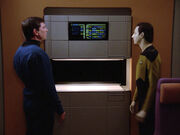
A food replicator aboard a Galaxy-class starship
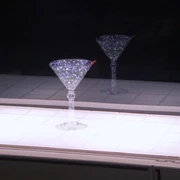
A replicated martini materializes
A replicator or molecular synthesizer was a device that used matter-energy conversion technology similar to a transporter to produce almost anything from a ship's replicator reserves. (TNG: "Lonely Among Us", "Deja Q"; DS9: "Visionary"; VOY: "Virtuoso"; ENT: "Dead Stop") It was also capable of inverting its function, thus recycling the item. (DS9: "Hard Time", "The Assignment", "The Ascent", "Prophet Motive", "Nor the Battle to the Strong"; VOY: "Memorial", "Fair Haven", "Mortal Coil") Items thus disposed of served to fuel the replicator and could potentially become other items in turn. (VOY: "Year of Hell")
Replicators were one of the technologies used in holodecks and holosuites, as well as in exocomps and self-replicating mines. (VOY: "The Cloud", "Twisted", "Dark Frontier", "Pathfinder", "Human Error"; TNG: "The Quality of Life"; DS9: "Call to Arms") They were commonplace among advanced Alpha Quadrant cultures like the United Federation of Planets, the Cardassian Union, and the Ferengi Alliance, but were largely unheard of in the Delta Quadrant, although a few species did possess them. (VOY: "False Profits", "State of Flux", "Caretaker", "Think Tank")
Replicators were capable of producing food as fresh and tasty as non-replicated foodstuffs, inorganically materialized out of patterns used by the transporters. (TNG: "Lonely Among Us") Most people found replicated foods and drinks to taste exactly the same as "real" food, although some people claimed to be able to tell the difference. Furthermore, Federation replicators could be programmed to produce foodstuffs of acceptable "nutritional value" despite resembling more indulgent items. (TNG: "The Price", "Sins of the Father", "The Wounded", "Relics"; DS9: "In the Pale Moonlight", "You Are Cordially Invited") Some people didn't learn to cook without a replicator. (TNG: "Family", "In Theory", "The Wounded"; VOY: "Human Error") Some smaller ships didn't bother to carry food or water, prefering to rely on their replicators to synethize what they needed, which saved on space but caused problems if the replicator was damaged. (TNG: "Final Mission")
In addition to foodstuffs, replicators could be used for replicating an almost limitless range of other objects. Complex devices (TNG: "The Game", "The Child"; DS9: "Rivals", "Captive Pursuit"; VOY: "Phage", "The Killing Game", "Dark Frontier", "Tsunkatse"), weapons (DS9: "Civil Defense", "Inquisition", "Call to Arms"; VOY: "Counterpoint", "Flesh and Blood"), machine components (DS9: "Distant Voices", "Image in the Sand"; VOY: "Extreme Risk", "One Small Step", "Latent Image"), clothing (TNG: "The Survivors"; DS9: "Distant Voices", "Paradise"; VOY: "Caretaker", "Vis à Vis", "Someone to Watch Over Me", "Flesh and Blood"), medication (VOY: "Latent Image", "Fury", "Body and Soul"), coins (TNG: "The Game", "The Perfect Mate"), musical instruments (TNG: "The Neutral Zone", "Inheritance"), antique furniture (VOY: "Lineage"), photographs (VOY: "Human Error"), and a wide range of other items. Industrial replicators could even be used to replicate heavier machine parts, to help build factories, power plants etc. (DS9: "For the Cause")
Users could program their own replication patterns into the replicator, such as a particular recipe for soup, a larger duplicate of a complex item, or an unusual device such as a wheelchair. Worf programmed an approximation of bloodwine into the USS Enterprise-D's replicators. (TNG: "The Outcast", "Lessons", "Gambit, Part II"; DS9: "Rivals", "Melora", "Destiny"; VOY: "Fury", "The Voyager Conspiracy", "Once Upon a Time") Elim Garak would program replicator patterns for clothing as he designed it. (DS9: "Distant Voices") Replicators included built-in scanners, allowing someone to make copies of an item without understanding its internal workings. (DS9: "Rivals")
Starfleet replicators kept logs of their use. (TNG: "Remember Me")
Starfleet replicator technology was theoretically capable of creating artificial substitutes for natural organs for use in certain transplants, such as eyes or lungs. (TNG: "Loud As A Whisper"; VOY: "Phage") A genetronic replicator could extrapolate actual organs for use in medical transplants from a DNA sample. (TNG: "Ethics")
Some alien replication technology was able to create living organic material, such as when the D'Arsay archive created living snakes. The "Allegiance" aliens were also able to create living things, as in the case of Jean-Luc Picard's impostor, for which the replicators were even able to recreate the dendritic connections where memory was stored. (TNG: "Masks", "Allegiance")
Limits
Replicators had limits to their functionality. If the object desired contained a certain degree of complexity in its molecular structure, it could not be replicated. (TNG: "The Enemy"; VOY: "Imperfection") Talaxian lungs were considered too complex to replicate, as Talaxian physiology included a complex series of neural links between the lungs and the rest of the body that replicators were unable to duplicate exactly. (VOY: "Phage") Certain medicatical compounds could not be replicated, nor could Cardassian plasma distribution manifolds (or rather the beta-matrix compositor used in making them), Borg cortical nodes, or bio-neural gel packs. (TNG: "Code of Honor"; DS9: "The Abandoned", "Empok Nor"; VOY: "Learning Curve", "Imperfection")
Certain materials, such as tricyanate and polyduranide, were considered difficult to replicate. (TNG: "The Most Toys"; VOY: "Scorpion", "Vis à Vis") For some reason, it took a long time to replicate nanoprobes. (VOY: "Scorpion", "In the Flesh")
Some citizens of the Federation, such as Robert Picard, refused to use replicators. Picard was opposed to their use and would not allow them on his property, complaining that they were destroying people's ability to cook, among other issues. (TNG: "Family") Similar but less extreme mindsets were not uncommon, and both Miles O'Brien's mother as well as Joseph Sisko raised their respective children believing that replicated food was less nutritious or generally "lacking". (TNG: "The Wounded"; DS9: "Homefront")
Some people claimed to be able to tell the difference between replicated and "real" food. Jean-Luc Picard admitted that their replicator did not do "justice" to caviar, so he kept some cases of it for special occasions. (TNG: "Sins of the Father") Worf claimed they did not do justice to Klingon Warnog. (TNG: "Rightful Heir") Aquiel Uhnari complained the Muskan seed punch she could replicate didn't match the sort her mother made for her. (TNG: "Aquiel") Eddington claimed that he could taste the fact his "curried chicken" was in reality "replicated protein molecules".(DS9: "Blaze of Glory") In 2366, Deanna Troi expressed her desire to the computer to have a "real" chocolate sundae. The computer wished for her to define "real in context", to which Troi explained, "Real. Not one of your perfectly synthesized, ingeniously enhanced imitations. I would like real chocolate ice cream, real whipped cream..." before she was interrupted by the computer explained that "[t]his unit is programmed to provide sources of acceptable nutritional value. Your request does not fall within current guidelines. Please indicate whether you wish to override the specified program?" (TNG: "The Price") In 2399, Troi and William T. Riker lived on Nepenthe, hunting and harvesting their own food. When Troi provided Soji Asha a tomato that she had harvested, Soji was surprised by how "real" it tasted in the comparison to the replicated food she had eaten all of her life. (PIC: "Nepenthe")
Not all replicators carried the same patterns. Jake Sisko was unable to find a replicator on Earth that carried the pattern for I'danian spice pudding as good as that available from the replicators on DS9. Runabout replicators carried particularly sparse menus. (DS9: "The Search, Part I", "In Purgatory's Shadow") The replicators on DS9 needed to be specially programmed with Cardassian food whenever Cardassian dignitaries visited. (DS9: "Destiny", "Ties of Blood and Water")
Replicators, or at least Romulan replicators, left distinctive patterns in the molecular structure of items they produced. (TNG: "The Mind's Eye")
Replicating large numbers of items could require significant amounts of power to be diverted from the warp core. (TNG: "The Child") Complex elements such as anicium and yurium also required large amounts of energy to replicate. (TNG: "Night Terrors") During emergency situations, the use the replicators might be restricted to save power for vital systems or because they were unreliable; requiring rations to be replicated instead of more elaborate food (TNG: "Yesterday's Enterprise"; VOY: "Year of Hell", "The Killing Game", "Demon"; DS9: "The Siege"), rationing of replicator usage (VOY: "The Cloud", "Real Life", "The Void"), or the use of traditionally-prepared food. (DS9: "Covenant"; VOY: "The Cloud") It was sometimes necessary to take the replicators completely offline to conserve power. (DS9: "Covenant"; VOY: "Dark Frontier", "Demon")
Replicators, or at least the Cardassian replicators on Deep Space 9, needed to be shut down weekly for routine maintenance. (DS9: "Heart of Stone")
Safety Limits
Replicators aboard Starfleet vessels would not produce fatal poisons. (VOY: "Death Wish") Furthermore, replicators had biofilters which automatically screened out all contaminants. (DS9: "Babel") Although clothing could be replicated for general wear, they would not allow non-Starfleet crewmembers to replicate official Starfleet uniforms. (VOY: "Caretaker") They produced synthehol versions of alcoholic drinks by default, but they could easily be manually readjusted through their control panel to make real alcohol instead. (TNG: "Up The Long Ladder")
On Starfleet installations and starships, if a person in custody was confined to quarters, it was standard policy to disable the replicators that the person had access to in order to ensure that a weapon could not be replicated. (DS9: "Inquisition"; VOY: "Counterpoint")
Makeup
Starfleet replicators made use of the alloy nitrium in their construction.(TNG: "Cost of Living") Components of a replicator included the replicator waveguide, power converter, power supply grid, memory, pattern buffers and the matter-energy conversion matrix. (TNG: "Cost of Living"; DS9: "Defiant", "Heart of Stone", "Visionary", "Our Man Bashir", "Nor the Battle to the Strong") A disruptor pistol had some components in common with a replicator. (DS9: "The Way of the Warrior") Voyager's replicator panels made use of bio-neural gel packs, were enhanced using several alien technologies they had acquired, and had their own secondary power supplies. (VOY: "Macrocosm", "The Void ", "Fair Haven", "Warhead ")
History and notable uses
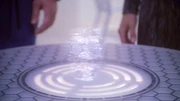
An advanced 22nd century matter-energy converter
One of the first replicators seen by Humans was the one seen by the crew of Enterprise when they had their ship repaired in a mysterious automated repair station. Prior to this, T'Pol once saw a similar device on a Tarkalean vessel that was capable of replicating almost any inanimate object. Until this time, the most comparable technology aboard 22nd century starships were protein resequencers, which had limited capabilities compared to later technologies. (ENT: "Dead Stop"; ENT: "Fight or Flight", "Oasis")
In the 23rd century, the United Federation of Planets had not yet perfected replicator technology for ships, though replicators already existed in industrial sites. Replicator technology was, however, in use by The Assigners, and the Beta 5 computer utilized replicator technology to manufacture several false identity cards for use by Gary Seven. (TOS: "Assignment: Earth") Starships of this time period were equipped with food synthesizers and other devices for producing clothing and machine parts on demand. This was a step forward, but did not achieve the quality and sophistication of the 24th century replicator. Replicator technology was not yet employed on starships as late as 2293. (TOS: "The Naked Time", "The Trouble with Tribbles"; VOY: "Flashback"; DIS: "Context Is for Kings", "The Butcher's Knife Cares Not for the Lamb's Cry", "Such Sweet Sorrow, Part 2")
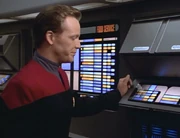
Paris using the food service in the mess hall
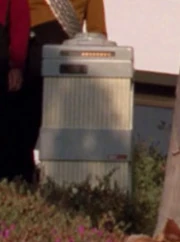
A portable matter replicator
24th century Federation starships were commonly equipped with replicators because they allowed for a wide variety of foods and beverages to be served to crew members and also allowed for replication of other objects. The selection was limited only by the software and the number of options that had been programmed. (TNG: "The Neutral Zone", "The Defector", "Sins of the Father", "All Good Things..."; DS9: "Trials and Tribble-ations"; VOY: "Caretaker", "Phage", "Twisted")
Captain Picard beamed down to Rana IV with a portable matter replicator for Kevin and Rishon Uxbridge in 2366. (TNG: "The Survivors")
When Beverly Crusher determined that a captured Romulan needed ribosomes to survive, she noted that the replicator could not be used due to the complexity of the molecular structure. (TNG: "The Enemy")
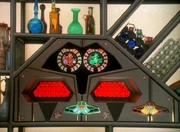
The replicators in Quark's Bar on Deep Space 9
As of 2367, Galaxy-class starships were equipped with a replicating center containing several replicator terminals resembling miniature transporter pads at which crew members could order items. Lieutenant Worf and Lieutenant Commander Data shopped the USS Enterprise-D's replicating center for a wedding present for Miles and Keiko O'Brien. (TNG: "Data's Day")
The Enterprise-D's replicators were used to provide blankets to a Bajoran refugee camp. (TNG: "Ensign Ro")
The replicator played a key role in spreading the Ktarian game around the Enterprise-D in 2368. (TNG: "The Game")
On the Promenade of the Federation space station Deep Space 9, the Replimat provided a casual location for inhabitants to enjoy a meal or beverage courtesy of a bank of replicators located along one of its walls. (DS9: "Emissary")
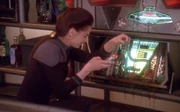
Dax repairing Quark's drink replicator
In 2374, the drink replicator at Quark's experienced a malfunction. To fix it, Quark submitted an emergency maintenance request in the morning, and was assured by Chief Miles O'Brien that Rom would be fixing it right away, however, Rom, in turn, promised Quark that Nog would fix it before the end of the day, however Nog never arrived, but in his place, Jadzia Dax showed up. Quark felt that that task was below her, and fixing a replicator was "work for a mechanic, a repairman, a lowly engineer." Quark later confessed to Odo that, "those hands weren't meant to be poking around inside a filthy drink replicator," as they observed her pulling a green goo from the replicator's insides. (DS9: "Valiant")
Replicators in the Delta Quadrant
"Nothing special. Date with a replicator."
"Cancel it, that's an order."
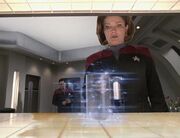
A replicator malfunctions and creates a mug – after the coffee
After the USS Voyager was pulled to the Delta Quadrant in 2371, an energy crisis occurred several weeks into the journey back to the Alpha Quadrant, and Janeway ordered replicator usage to be rationed in order to conserve power for other key systems. These replicator rations became a type of currency among its crew. (VOY: "The Cloud")
The Ocampa were provided with food dispensers by the Caretaker in their underground city on Ocampa. (VOY: "Caretaker")
Later that year, it became very clear that replicator technology was unknown to the indigenous people of the region around the Ocampan homeworld. The Kazon, in particular, repeatedly tried to obtain this technology, as did other races. Captain Janeway feared that if this technology was acquired by a civilization before it was ready, disastrous consequences could ensue. For this reason, and because of the Prime Directive, Janeway refused to give up this technology at any price. (VOY: "State of Flux") By 2377, however, the crew of Voyager had shared replicators to help people feed and clothe themselves a number of times. (VOY: "Flesh and Blood") In contrast, the Ferengi Arridor and Kol used a portable replicator to pass themselves off as the Holy Sages of the Takarians. (VOY: "False Profits")
In 2374 in the alternate timeline known as the Year of Hell, the replicator system on Voyager was heavily damaged by attacks from Krenim warships, forcing the crew to go to emergency rations. (VOY: "Year of Hell")
In 2377, Voyager acquired technology from a race within the Void that had joined The Alliance which tripled the ship's replicator efficiency. (VOY: "The Void")
In 2378, the young Q manipulated a replicator to tell Janeway "Make it yourself" when she asked it for coffee. (VOY: "Q2") Janeway herself had a tense relationship with her personal replicator. After it burned a pot roast, not the first time it had done so, she told Commander Chakotay that she had once referred to it as a "glorified toaster" and it had never forgiven her. (VOY: "Shattered")
See also
- Fabrication device
- Industrial replicator
- Matter-energy conversion matrix
- Matter synthesizer
- Protein resequencer
- Self-replication
Appendices
Background information
The idea of replicators was unpopular with the writers of The Next Generation and Deep Space Nine. Ira Steven Behr commented: "I'd like to lose the replicators. They're my least favorite thing in Star Trek. A society that uses replicators is a doomed, finished society." (Star Trek: Deep Space Nine Companion) Ronald D. Moore added that "Replicators are the worst thing ever. Destroys storytelling all the time. They mean there's no value to anything. Nothing has value in the universe if you can just replicate everything, so all that goes away. Nothing is unique; if you break something, you can just make another one. If something breaks on the ship, it's "Oh, no big deal, Geordi can just go down to engineering and make another doozywhatsit." Or they go to a planet and that planet needed something: "Oh, hey, let's make them what they need!" We just hated it and tried to forget about it as much as possible." [1]
Per an odd after-credits scene in the Star Trek: Short Treks episode "The Trouble with Edward", 23rd century food synthesizers apparently incorporated replicator safety protocols, although it remains unconfirmed that replicators incorporated these as well.
Replicators are considered as Star Trek predicting technology, like 3D printing, in part.
External link
- Replicator at Memory Beta, the wiki for licensed Star Trek works
